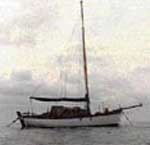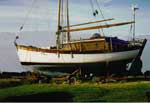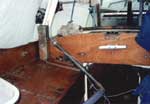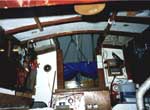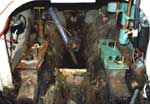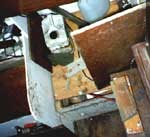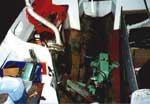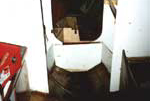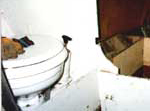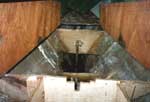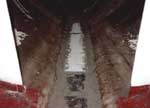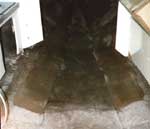|
|
The
Restoration of a Tamarisk
24 October
1997 to – (Will it every be completed?) Denys
Harland, Michael & Sue Swarbrick and now by new owners John & Issy Edginton
|
|
||
|
1998
Click on photos for a bigger picture. Click on browser 'back' button to return to main document. Some 'Before' pictures
|
History of the
Tamarisk The original Tamarisk was built by North Sea Craft in Norwich where she was moulded in GRP direct from an original East Coast 19th century fishing smack and was only 22 feet long. Our Tamarisk is also based on traditional designs but from the West Country. Her designer David Cannell is said to have distilled designs like the Itchen Ferry and Falmouth Quay Punt into her. She is a traditional gaff rigged topsail cutter with a 'deep forefoot with a long run of keel not over deep, a little more beam, but still with a fine entry and firm quarters at the transom stern' - Boat Magazine, March 1979. She won the 'Best West Country Built Boat Award' in 1979. Hopefully, she will win the Best Rebuilt Boat Award of 1999. He was a very quiet person and unfortunately little is known about him as he was only beginning to 'circulate' amongst the club's elder statesmen when his untimely death was brought about by a heart attack. He lived alone and perhaps if he had had a companion he would still be with us. I am writing this on Christmas Day 1998 and it is with sadness that one thinks of all the lonely people in the world. Malcolm's boat was dying with him, but we hope to bring it back to life, sadly something we can't do for Malcolm but the boat will be there so we will remember him. On his death the boat passed to Malcolm's sister, Barbara Joy Bell, who lives on the outskirts of Bath. Malcolm lived in Bebbington in the Wirral and we think his boat started out on the Mersey, possibly only coming to Glasson because it was near where he worked, in fact we know he lived on her, in the basin, during the week whilst he was at work. Strangely I have some pictures of her in pristine condition in the eighties on the club's then new trailer that Denys, Peter Wragg and I built If anyone has any more information about I suppose it was the 'romantic' idea of a sail training ship for this Club's youngsters that inspired us to be reckless and buy it. It will be interesting to see if we ever take any youngsters on board. I think they would have to be orphans because no sane parent would trust their childrens' lives to a couple of old 'Long John Silvers' like us. Young Dennis of Weasel says he will never sail on a traditional boat again after his adventures this year in a similar but larger boat. |
1998 Click on photos for a bigger picture. Click on browser 'back' button to return to main document. More 'Before' Pictures
|
||
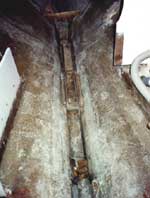 Some of the forward recast ballast in position. The small ply bulkhead at the top of the picture is the start of the bow well. |
First Task – Ballast Before we did any fibre glassing the hull was ground clean as can be seeen in the picture of the left wher the ballast has still to be glassed in. As you can see in these and subsequent pictures we removed the interior woodwork as we went along. In hindsight it would have been much easier to clean the whole lot out first but we hadn't decided exactly what we were going to keep? |
|
||
Tamarisk Home Page |
|
|||
